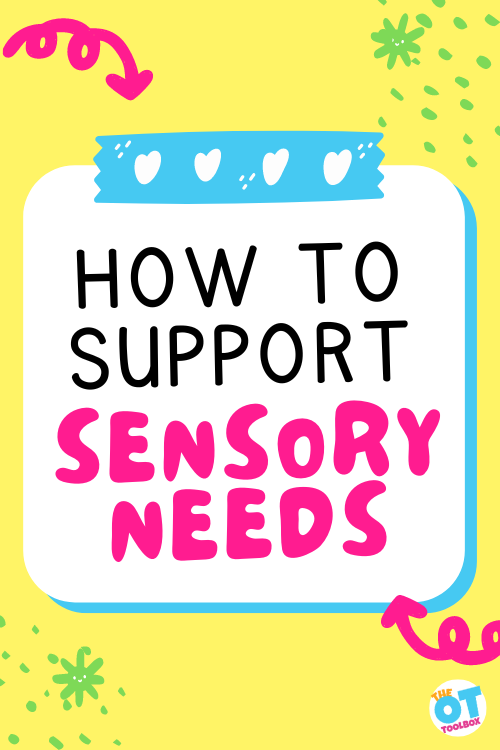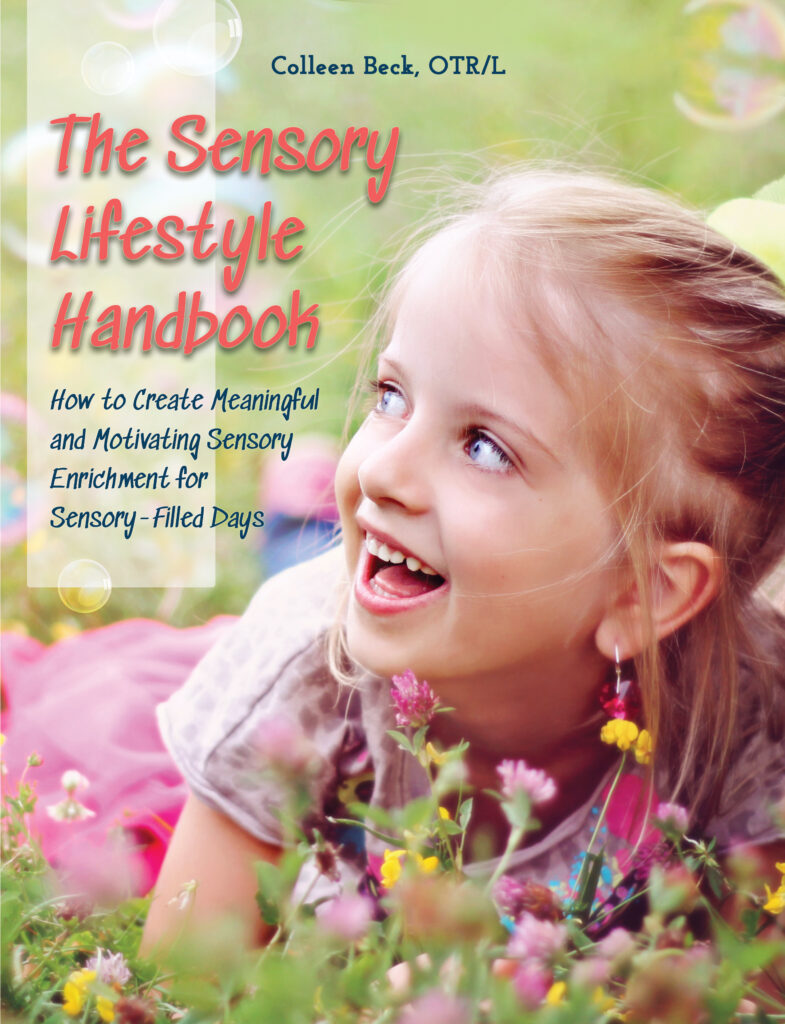When it comes to sensory arousal level, we all have different sensory needs. In this blog post, we’ll cover what sensory needs look like for different individuals and how to support these various levels of sensory requirements. “Sensory” can mean many things to different people, and we are all different!

What are sensory needs?
All of us have sensory preferences. We might prefer a cozy sweater because it’s thick and keeps us warm, but another person can’t stand how scratchy it feels to them. Some people enjoy feeling the breeze flowing in a window on a Spring day, but to others, the cool air is annoying and they can’t help but focus on the sounds of the outdoors.
Each of us has sensory needs in which we can and can not function.
When our sensory needs are not met, we are distracted, unorganized, and can’t focus on the task at hand. The various input takes precedence in our minds and to all of our senses.
For the individual who is hyper aware of sensory input, or is unable to adjust or accommodate for the aggravating types of input, we might see challenges in function.
Understanding different sensory needs via a sensory checklist can be a helpful first step.
When sensory needs are not met
When sensory needs are not met, dysfunction can result. We may see issues with self-regulation, including behaviors and emotional considerations.
One way to look at it is this way:
Shoes and hats are concrete examples. So are temperature regulation, tactile experiences, sounds, smells, sights, and tastes. It is fairly easy to identify these challenges and make adjustments. If you are too cold, add a sweater. Too hot? Take it off. When the music is too loud, you turn it down, add headphones, or move away from the sound. If something is too sticky, you might wash your hands, avoid that experience, or wear gloves.
Of course, life is not that easy.
Sometimes you can not get away from the incoming toxic information, or find a way to regulate it. This affects the just right challenge, as this offending data changes mood, focus, attention, and overall feeling of calm.
Sensory input is an acceptable strategy for many responses related to sensory needs. Sometimes undesirable behaviors impact an individual’s ability to function or safely participate in a daily lifestyle. Some behaviors impact a family or classroom in a non-functional manner. These are behaviors that should be addressed in a manner that allows the individual to get the sensory input they need. Behaviors that can progress toward unhealthy or unfunctional manners may include:
- Emotional overreaction
- Meltdowns
- Aggression
- Hyper-attention
- Difficulty with transitions
- Inattention
- Sleep issues
- Impulsivity
- Sensory-seeking behaviors
- Sensory-resisting behaviors
- Resistance to textures/food/clothing
- Poor social Interactions
A note about meltdowns: Meltdowns (in a way that becomes unsafe or dysfunctional for the family or classroom on a consistent basis. Dysfunctional classroom or family life indicates a sensory need that is unmet. Meltdowns are a common result of those with sensory processing difficulties, those who may be unable to communicate needs, or those with emotional/social challenges. Consider meeting the need that creates the meltdown by analyzing needs and preferences.
When sensory needs are not met, we might see
- Avoidance – one technique includes avoiding the offending item or experience. Move away from a terrible smell, turn off the scary movie, say no to a dip in the freezing pool. This is a good strategy but not foolproof. In individuals that can not regulate sensory needs, you’ll see meltdowns, outbursts, etc.
- Accommodate – made adjustments to the sensory experience. Change clothes to find comfortable ones. Wear headphones or earplugs during loud events. Cover your nose if something smells offensive. Wear gloves when touching sticky foods. Add ketchup to gross vegetables. Again, this is not 100% foolproof either.
- Grin and bear it – sometimes input can not be avoided or accommodated. One example: the fire alarm is going off. You are unable to avoid it because it is an alert. You are holding two kids’ hands, so you cannot plug your ears. Just remind yourself it will be over soon, take some deep breaths, and plan to self-regulate after the event is over. We know that grinning and bearing it is not always an option for everyone, especially the neurodiverse. This is when we may see breakdowns, meltdowns, avoidance, and other responses.
(Amazon affiliate link): The Highly Sensitive person is a great resource for helping understand these sensory challenges and work through them.
Amazon affiliate links are included in this blog post. As an Amazon Influencer, I earn from qualifying purchases.
AROUSAL LEVEL
Sensory arousal level is similar to a mood regulator. The just right challenge to balance these feelings is difficult. It is hard to regulate ones level of fatigue, happiness, frustration tolerance, focus, calm, or anxiety, to name a few.
Arousal level is similar to a wave. We move through this wave up and down all day long. The key is to be in the middle of the wave, but this does not always happen.
For some people, it rarely happens. Some people find their arousal level is generally low. They are sluggish, despondent, depressed, lacking motivation, and unable to complete tasks.
The other side of the wave are those folks who are always up. They are in constant motion, on the go, fidgety, unable to stay on task, talk too much, get too close to other people, overexcited, and restless. Either end of the wave is not as productive as the middle.
You can’t always set up the optimal environment
Sometimes there are events that are out of our control. Imagine an airplane ride. There are several accommodations that can be made for comfort. Layered clothing for temperature regulation. A blanket and pillow for temperature and comfort. Headphones or earplugs to regulate noise. Cover your nose while the person next to you eats tuna salad.
You cannot change the vestibular input from the movement of the plane, and perhaps the proximity of the person next to you. By changing a few things, the rest of the offensive stimuli is more tolerable. Coping strategies can support this need.
How to support sensory needs
The just right challenge involves finding the middle of the wave. This is not easy. There are times when we add too much calming input to an overstimulated learner, only to find they went way past the middle, leaving them in a virtual coma. Or treatment included alerting activities to wake the sensory system. This overshot “normal” and now your learner is bouncing off of the walls.
With Evidenced Based Practice, practitioners are searching for research and hypotheses about the just right challenge. Rely on practice, observation, gathering data to that specific learner, and a lot of trial and error.
Heavy work – When it comes to sensory needs, heavy work is an option for the just right challenge in meeting differing needs. The proprioceptive system sends messages about our muscles and joints, and position in space. It lets the brain know where the body is at that exact moment.
Arousal level is regulated by proprioceptive input. Proprioceptive input is gained through heavy work.
Pushing, pulling, carrying, lifting, and exercising are examples of input.
Activities that provide input through the joints and receptors in the muscles/joints have a calming effect on sensory needs. Activities can be exercise-based (therapy bands, animal walks, jumping jacks, etc.) or they can be functional in nature (removing wet laundry from the washing machine, helping in the garden, vacuuming, etc.)
Activities can also be easily incorporated into environments and schedules such as utilizing a sports bottle with a straw or adding proprioceptive input into writing tasks with a weighted pencil. Activities below can be incorporated into an individual’s day to address needs of the proprioceptive sense.
Adaptations/Accommodations to offer heavy work input may include:
- Traditional exercise
- Weight lifting
- Chores
- Playing on playground equipment
- Bicyling
- Swimming
- Yoga
- Heavy work input through push and pull activities such as tug-of-war
- Pulling a full wagon
- Pushing a wheelbarrow
- Pushing heavy chairs on a carpeted floor
- Moving furniture
- picking up and carrying a full laundry basket
- Shoveling snow or dirt
- Wearing a heavy backpack
- Mopping floors
- Carrying a stack of books
- Wall push-ups
- Chair push-ups
- Wall sits (“sit” with the back against the wall as if on an imaginary chair)
- Roll up in a blanket
- Massage
- Weighted blanket
These strategies can be part of a sensory diet that meets specific and individual sensory based needs.
Modification – adding external input to improve the sensory arousal level. A weighted or compression vest can add great input to help with regulation.
There is controversy about the effectiveness of these vests, however they work well for many learners. Ankle weights can be added for input, regulation, and body awareness.
Take a sensory break – Sometimes less is more. There are times when the body needs a break from it all. Curl up on the couch with a book, under a blanket, with the lights dimmed. Sit on the porch in a rocking chair feeling the breeze. Young learners can benefit from afternoon quiet time to rest and reflect. Slowing down takes practice.
Coping strategies– Using a variety of coping strategies can support sensory needs.
Focus on the good– Turning the focus onto student strengths is a great tactic! When we focus on the individual strengths, we can come up with meaningful and motivating strategies that meet differing needs. This is a huge component in creating a sensory lifestyle.
Regulation and finding the various levels of requirements that support function isn’t always easy. This is the reason so many practitioners lean toward evidenced based practice. A=B.
The data shows adding eye glasses improves vision. A cast works well to heal a broken leg. Unfortunately, sensory integration involves trial and error, luck, practice, and a large toolbox.
For more information on this theory and and understanding of what is happening when we see behavioral outputs, or actions as a result of sensory perception from sensory input, please check out our resource on Ayres Sensory Integration.
Accommodation, avoidance, regulation, heavy work, modification, and a treasure chest of ideas, are the keys to finding the perfect level of sensory needs.

Colleen Beck, OTR/L has been an occupational therapist since 2000, working in school-based, hand therapy, outpatient peds, EI, and SNF. Colleen created The OT Toolbox to inspire therapists, teachers, and parents with easy and fun tools to help children thrive. Read her story about going from an OT making $3/hour (after paying for kids’ childcare) to a full-time OT resource creator for millions of readers. Want to collaborate? Send an email to contact@theottoolbox.com.
The Sensory Lifestyle Handbook walks you through sensory processing information, each step of creating a meaningful and motivating sensory diet, that is guided by the individual’s personal interests and preferences.
The Sensory Lifestyle Handbook is not just about creating a sensory diet to meet sensory processing needs. This handbook is your key to creating an active and thriving lifestyle based on a deep understanding of sensory processing.



